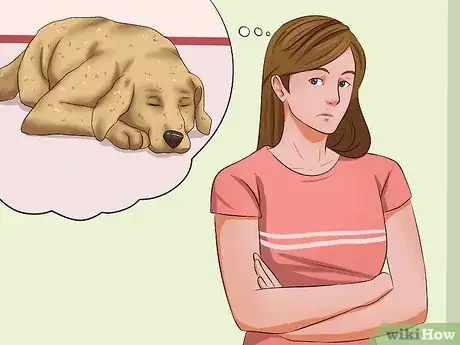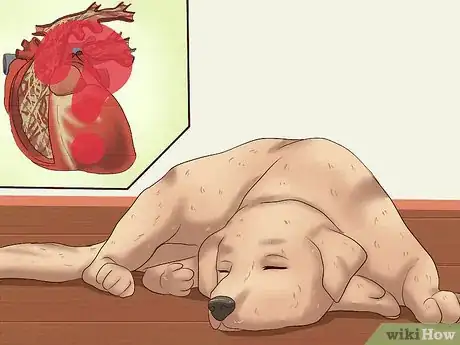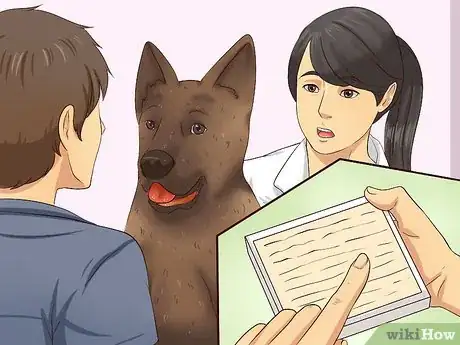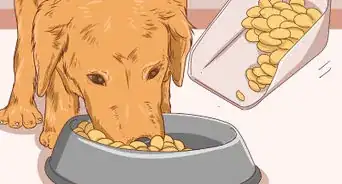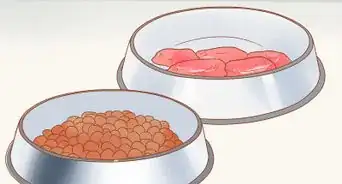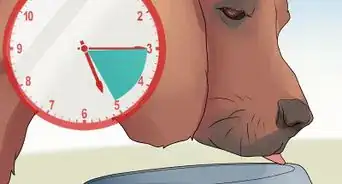This article was co-authored by Brian Bourquin, DVM. Brian Bourquin, better known as “Dr. B” to his clients, is a Veterinarian and the Owner of Boston Veterinary Clinic, a pet health care and veterinary clinic with three locations, South End/Bay Village, the Seaport, and Brookline, Massachusetts. Boston Veterinary Clinic specializes in primary veterinary care, including wellness and preventative care, sick and emergency care, soft-tissue surgery, dentistry. The clinic also provides specialty services in behavior, nutrition, and alternative pain management therapies using acupuncture, and therapeutic laser treatments. Boston Veterinary Clinic is an AAHA (American Animal Hospital Association) accredited hospital and Boston’s first Fear Free Certified Clinic. Brian has over 19 years of veterinary experience and earned his Doctor of Veterinary Medicine from Cornell University.
This article has been viewed 38,780 times.
Most dogs will have some type of stomach upset in their lifetime, perhaps even frequently. Stomach problems mean diarrhea, vomiting, flatulence and loss of appetite. Most of time, it is a passing mild illness easily treated at home, but occasionally it can be something more severe. This article will help you to work through to determine if your dog’s stomach troubles are mild and can be treated at home or if you need to call a professional to help your canine friend.
Steps
Deciding to Visit the Vet
-
1Recall if this is the first time. If this is the first time your dog has had a digestive problem or if you have a young puppy, call your veterinarian for advice. Small dogs and puppies have small body reserves, so even mild diarrhea can lead to rapid dehydration.[1]
- Young puppies are particularly susceptible to parvo.[2]
- Dogs can seem like picky eaters the first time they are in a new home or environment. Talk with your veterinarian about what to expect during the first few days you own a dog.
-
2Rule out chronic disease. If your dog has a chronic illness or condition, ask your vet if you should expect stomach upsets as a symptom of your dog’s illness.[3] You can create a treatment plan in advance to help manage the stomach problems when they occur.Advertisement
-
3Rule out medication. If your dog is taking medicine, ask your vet or read the label to know the potential side effects. Some medication may induce nausea, diarrhea, or other stomach problems.
- If you think a medication is causing your dog’s sickness, talk to your vet and request a different medicine.
- Your dog may vomit out or excrete necessary medications even if this is a garden-variety stomach ache. Talk to your veterinarian about how to make up missed doses of medication.
-
4Rule out toxic food. There are certain foods that are toxic to dogs and that you should never feed your dog. Some of these foods can cause stomach upsets, while some can lead to serious medical problems, emergency treatment and occasionally quick death. Seek veterinarian attention immediately if your dog may have eaten any of these:[4]
- Raisins and grapes
- Spoiled meats or foods, moldy foods
- Cooked bones—the cooking makes them brittle and unsafe for consumption
- Gum or food made with xylitol
- Alcoholic beverages
- Avocados
- Macadamia nuts and walnuts
- Onions, garlic
- Tea, coffee or anything containing caffeine
- Chocolate in any form
- Dough made with yeast
- Cherry, apricot, peach pits and apple and mustard seeds.
-
5Rule out trauma. If there has been any trauma, especially a blow or injury to the head, chest or abdomen, call your veterinarian for advice. Your dog may be concussed, in shock, or experiencing internal damage.[5]
-
6Examine your dog’s waste. It is not uncommon for dogs with stomach problems to experience diarrhea and vomiting, much like humans do. If your dog’s vomit, diarrhea, or urine looks unusual, contact your veterinarian.[6]
- Especially if you notice any blood, blood-like, or black-tarry substance in the vomit or diarrhea. A black, tarry substance in poop might be digested blood.
- Especially if your dog is retching uncontrollably or has unproductive vomiting. This could be a symptom of bloat (generally an issue with deep chested large breed dogs) and is a medical emergency.
-
7Go to the vet. If you do not know what is causing your dog stomach problems and your dog seems truly ill, your best treatment involves seeking a professional. If your dog has dull eyes, lack of energy, lack of appetite, blood in vomit or stool, or a painful belly, your dog may have a severe infection. All severe ones require professional help.[7]
- All infections require adequate fluid intake to treat. Usually this means drinking enough water.[8]
- Severe cases of infection require intravenous treatment, nutrition, and medications. Non-infectious disease treatment might also involve blood tests and x-rays. [9]
- Certain disease conditions within the body—such as liver, pancreas, intestinal, stomach disease—will show as diarrhea, vomiting and/or loss of appetite.
- Only bacterial infections will respond to treatment with antibiotics. Your veterinarian will make a decision as to whether bacterial infection is likely and thus whether to use antibiotics.
- Roundworms (and other intestinal worms) will be treated by specific medications.
- There are no specific medications that treat viruses in dogs. However it may be necessary to give your dog supportive care, such as intravenous fluids or drugs to prevent nausea, while the dog's immune system fights the virus.
- If your dog isn't eating its usual food, go to the vet. They can help you figure out if there's an underlying issue causing your dog's loss of appetite.[10]
-
8Rule out food sensitivity. Dogs can have an intolerance or sensitivity to food; a true food allergy is rare and typically shows up as a skin issue. If you are unsure about a food sensitivity, eliminate all the common foods that cause sensitivity in your dog’s diet. Replace with a novel, or never eaten food, for a few weeks. Gradually reintroduce various foods to see if the stomach problem reoccurs. Common food sensitivities include:[11]
- Grains such as corn or wheat
- Commonly fed meats such as chicken and beef
- Eggs
- For example: try replacing these with boiled potato or duck
- If the stomach problem still prevails despite diet changes, contact your veterinarian.
-
9Double-check your water source. What kind of water is your dog drinking? Sometimes, there are chemicals in your water that are safe for humans, but not dogs. Try switching up what water your dog drinks: try bottled water, filtered water, or water from a different faucet. If the stomach problem prevails, try switching other aspects of the diet, or contact a veterinarian.
Treating Mild Stomach Problems
-
1Provide water constantly. Your dog must be well hydrated in order to avoid dehydration, which can lead to serious complications. However, make sure your dog is not overindulging in water, or drinking too fast.[12]
- Sometimes, drinking too rapidly can cause nausea and vomiting
- Contact your veterinarian if your dog is unwilling to drink water
-
2Withhold all food for 12-24 hours. You must rest the stomach to give your dog’s digestive system time to reset. When your dog seems calm and comfortable enough to eat again, move on to the next step.[13]
-
3Calculate how much food to make. You will be making a bland mush for your dog to eat while experiencing stomach problems. Find out how much your dog weighs in pounds (lbs). Divide this by 10. Multiply by 1.25. This is the number of cups of food you should make.[14]
- Amount of food you need to make for 1 day (in cups) = 1.25 * [(your dog’s weight)/10]
- For example, if your dog weighs 30 pounds, you will need 3.75 cups a day.
-
4Make a bland diet. The general ratio for a good recovery dog food is ⅔ white rice and ⅓ white meat. This white meat can be chicken, rabbit, or white fish.
- The rice should be cooked and soft
- Add beef broth if desired, or if you have a picky eater
- Avoid red meats, eggs, and cottage cheese. These foods are not bland enough.
-
5Serve this diet as symptoms disappear. Feed your dog in 5 servings spaced throughout the day. Feed your dog only this and water.[15] This bland diet and water should help your dog’s digestive system get back on track.
-
6Serve this same diet for 2 more days. This ensures your dog’s digestive system is healthy and clear of infection, and that your dog can handle more complicated food. If symptoms reappear, keep serving this diet until symptoms disappear again, and then for 2 more days still. If the reappearance of symptoms seems concerning, contact your vet.
-
7Serve 1/2 this diet for 2 more days. The other half of your dog’s food should be from its regular dog food.[16]
-
8Resume normal diet. After a few days of rest and a bland diet, your dog should be back to his normal self. If your dog is not better, the symptoms reappear, or the symptoms seem to get worse (lack of energy, refusing to eat, blood in vomit or stool, painful belly), contact your veterinarian.[17]
Expert Q&A
Did you know you can get expert answers for this article?
Unlock expert answers by supporting wikiHow
-
QuestionWhat causes an upset stomach in dogs?
 Pippa Elliott, MRCVSDr. Elliott, BVMS, MRCVS is a veterinarian with over 30 years of experience in veterinary surgery and companion animal practice. She graduated from the University of Glasgow in 1987 with a degree in veterinary medicine and surgery. She has worked at the same animal clinic in her hometown for over 20 years.
Pippa Elliott, MRCVSDr. Elliott, BVMS, MRCVS is a veterinarian with over 30 years of experience in veterinary surgery and companion animal practice. She graduated from the University of Glasgow in 1987 with a degree in veterinary medicine and surgery. She has worked at the same animal clinic in her hometown for over 20 years.
Veterinarian
-
QuestionWhat should I do if my dog won't eat?
 Brian Bourquin, DVMBrian Bourquin, better known as “Dr. B” to his clients, is a Veterinarian and the Owner of Boston Veterinary Clinic, a pet health care and veterinary clinic with three locations, South End/Bay Village, the Seaport, and Brookline, Massachusetts. Boston Veterinary Clinic specializes in primary veterinary care, including wellness and preventative care, sick and emergency care, soft-tissue surgery, dentistry. The clinic also provides specialty services in behavior, nutrition, and alternative pain management therapies using acupuncture, and therapeutic laser treatments. Boston Veterinary Clinic is an AAHA (American Animal Hospital Association) accredited hospital and Boston’s first Fear Free Certified Clinic. Brian has over 19 years of veterinary experience and earned his Doctor of Veterinary Medicine from Cornell University.
Brian Bourquin, DVMBrian Bourquin, better known as “Dr. B” to his clients, is a Veterinarian and the Owner of Boston Veterinary Clinic, a pet health care and veterinary clinic with three locations, South End/Bay Village, the Seaport, and Brookline, Massachusetts. Boston Veterinary Clinic specializes in primary veterinary care, including wellness and preventative care, sick and emergency care, soft-tissue surgery, dentistry. The clinic also provides specialty services in behavior, nutrition, and alternative pain management therapies using acupuncture, and therapeutic laser treatments. Boston Veterinary Clinic is an AAHA (American Animal Hospital Association) accredited hospital and Boston’s first Fear Free Certified Clinic. Brian has over 19 years of veterinary experience and earned his Doctor of Veterinary Medicine from Cornell University.
Veterinarian
Warnings
- If diarrhea lasts for more than 3 days, contact your veterinarian immediately.⧼thumbs_response⧽
- If your dog’s health deteriorates or your dog gets sicker over the course of treatment, contact your veterinarian immediately.⧼thumbs_response⧽
Things You'll Need
- Dog
- white chicken meat, rabbit meat, or white fish
- rice
- water
- Beef broth (optional)
- calculator (optional)
References
- ↑ Tilley, L. a. (2011). Blackwell's Five-Minute Veterinary Consult: Canine and Feline. Wiley-Blackwell.
- ↑ Ford, R. B. (2006). Kirk and Bistner's Handbook of Veterinary Procedures and Emergency Treatment. Saunders.
- ↑ Nelson, R. a. (2013). Small Animal Internal Medicine, Fifth Edition. Mosby.
- ↑ Kahn, C. a. (2010). The Merck Veterinary Manual 10th Edition. John Wiley and Sons.
- ↑ Tilley, L. a. (2011). Blackwell's Five-Minute Veterinary Consult: Canine and Feline. Wiley-Blackwell.
- ↑ Tilley, L. a. (2011). Blackwell's Five-Minute Veterinary Consult: Canine and Feline. Wiley-Blackwell.
- ↑ Ford, R. B. (2006). Kirk and Bistner's Handbook of Veterinary Procedures and Emergency Treatment. Saunders.
- ↑ Ford, R. B. (2006). Kirk and Bistner's Handbook of Veterinary Procedures and Emergency Treatment. Saunders.
- ↑ Ford, R. B. (2006). Kirk and Bistner's Handbook of Veterinary Procedures and Emergency Treatment. Saunders.
- ↑ Brian Bourquin, DVM. Veterinarian. Expert Interview. 20 December 2019.
- ↑ Kahn, C. a. (2010). The Merck Veterinary Manual 10th Edition. John Wiley and Sons.
- ↑ Tilley, L. a. (2011). Blackwell's Five-Minute Veterinary Consult: Canine and Feline. Wiley-Blackwell.
- ↑ Tilley, L. a. (2011). Blackwell's Five-Minute Veterinary Consult: Canine and Feline. Wiley-Blackwell.
- ↑ Tilley, L. a. (2011). Blackwell's Five-Minute Veterinary Consult: Canine and Feline. Wiley-Blackwell.
- ↑ Tilley, L. a. (2011). Blackwell's Five-Minute Veterinary Consult: Canine and Feline. Wiley-Blackwell.
- ↑ Tilley, L. a. (2011). Blackwell's Five-Minute Veterinary Consult: Canine and Feline. Wiley-Blackwell.
- ↑ Tilley, L. a. (2011). Blackwell's Five-Minute Veterinary Consult: Canine and Feline. Wiley-Blackwell.
